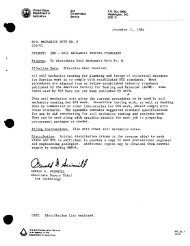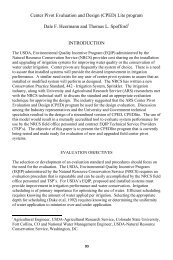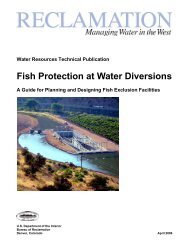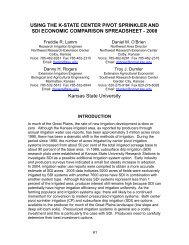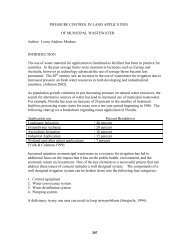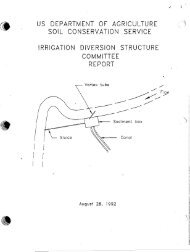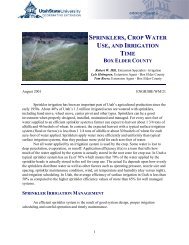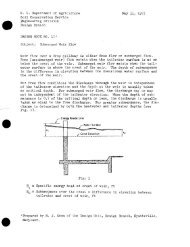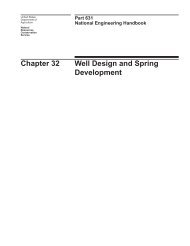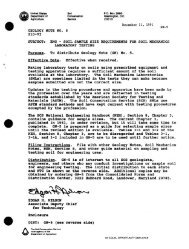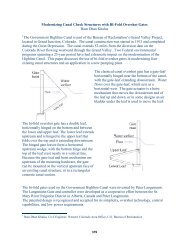NEH 16 Chapter 1 - NRCS Irrigation ToolBox Home Page
NEH 16 Chapter 1 - NRCS Irrigation ToolBox Home Page
NEH 16 Chapter 1 - NRCS Irrigation ToolBox Home Page
You also want an ePaper? Increase the reach of your titles
YUMPU automatically turns print PDFs into web optimized ePapers that Google loves.
Drainage coefficients for pumping plantsDrainage coefficients for pumping plants are based on the crite,ria used fordesign of the drainage system which delivers water to them. Characteristicsof flow to the pumping plant, whether surface, subsurface, or both, should beconsidered in determining the pumping capacity of the pumps. Most pumping plantsare designed with a certain amount of storage in the forebay of pumps, whichshould be considered in relating the flow from the contributing area to thepumping capacity required. Surface drainage systems usually have substantialstorage capacity below the elevation which will result in crop damage and whichcan be utilized to reduce the pumping capacity required (17). The flow fromsubsurface systems is much more uniform and less forebay storage is needed.Drainage coefficients for watershed protectionWatershed-protection plans should be developed to create good conditions forplant growth, including protection against excess surface water and control ofsoil-moisture content. To assure these conditions, all multiple-purpose orflood-prevention channels, into which lands requiring drainage must outlet, shouldhave capacities no less than those based on the applicable drainage coefficients.Where lands requiring drainage are planned for protection by flood-water-retardingstructures and channels, the channel system should provide no less protectionthan that established by the drainage coefficient. Such a design requires thatthe entire watershed area be taken into account. Flow from flood-water-retardingstructures should be added to the flow from unprotected uplands and flood-plainlands which is based on appropriate drainage coefficients for such unprotectedland.Special requirements for flatlandIn considering - the runoff from flatlands requiring drainage systems, it is importantto consider the influence of extensive surface-drainage systems on therequired capacity of the main ditches. Flatlands may have a large amount ofsurface storage in shallow depressions and a low rate of runoff before installationof water collection and disposal systems. As drainage collection and disposalsystems are installed, both surface storage and time of concentrationdecrease. The long-range trend of agricultural development needs to be studiedin determining the coefficients applicable to main drainage ditches for extensiveareas of flatland.Depth to water tableOptimum depth to water table is the subject of considerable research in theUnited States; and also in the Netherlands, where water tables can be controlledwithin close limits throughout the growing season in much of the country (18).One of the main factors involved is the quality of water. If it is free fromsalts, indications are that the water table needs to be only as deep as requiredto provide sufficient root zone depth for support of plants to be grown and tosupport tillage equipment. As roots generally do not penetrate deeper thanapproximately one foot above the water table the depth to water table should beapproximately one foot more than the depth of the root penetration desired.Where salts are present the water table must be deep enough to prevent capillaryflow from bringing dissolved salts up into the root zone.Pumped-Well DrainagePumped wells have effectively drained land in some locations. Though costly andrestricted to favorable geologic conditions, pumped wells are versatile and mayhave an economic advantage over other methods of lowering and maintaining adesirable water-table level.



